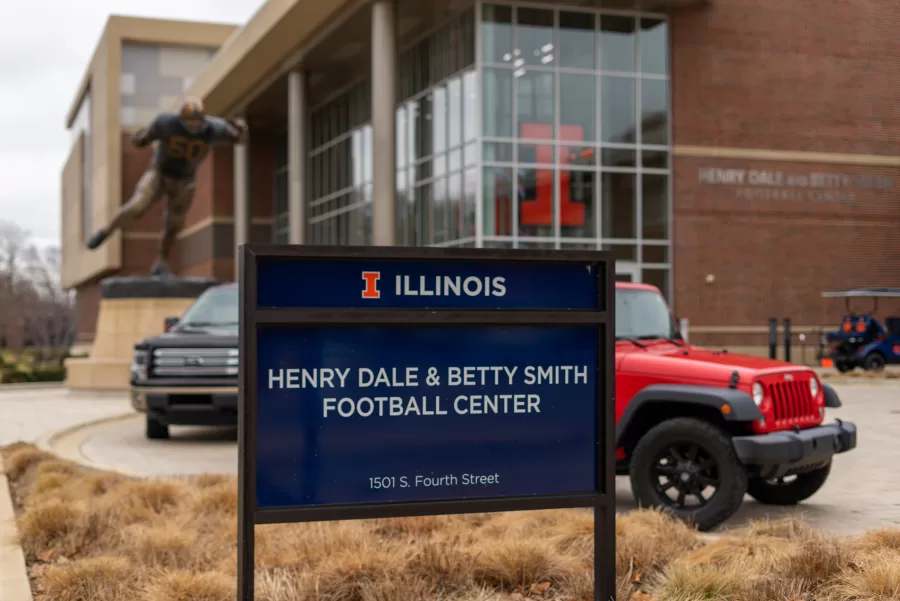Letter to the Editor | End the Student Athletic Facilities Fee
The Henry Dale and Betty Smith Football Center is located at the corner of South Fourth Street and Peabody Drive. The facility houses a strength and conditioning complex and a grand lobby, among other amenities.
Jan 20, 2023
Students at the University of Illinois at Urbana-Champaign paid $50,862,824 for a mandatory “athletic facilities fee” from 2005-2021, according to my customized analysis based on the Knight-Newhouse College Athletics Database. This fee is separate and apart from the student fee that supports the State Farm Center, which amounts to $43.35 per semester.
Figures for 2022 athletic revenues from student fees aren’t published yet, but University students pay $34.63 each semester for the athletic facilities — or $69.26 per academic year.
Campus enrollment in September totaled 56,664, with 47,670 full-time students. If only full-time students paid the fee, this would have generated an additional $1,650,812 in fall semester revenue for the athletic department.
No school in the Big Ten collected so much in fees for their athletic program from their students over this 16-year period (Maryland and Rutgers weren’t in the conference in 2005 but they assessed higher annual fees).
The Knight-Newhouse College Athletics Database shows that most Big Ten schools don’t charge students any athletic fees (Indiana, Michigan, Michigan State, Minnesota, Nebraska, Penn State, Purdue, Ohio State and Wisconsin).
Get The Daily Illini in your inbox!
The head of the National College Players Association, Ramogi Huma, put this problem in a broader perspective when the LA Times published his letter to the University of California Regents in early December.
Explaining his opposition to UCLA’s defection to the Big Ten, Huma said: “UCLA does not have a revenue problem, it has a spending problem.”
This is true for Illinois athletics, too.
In its 2021 annual financial report to the NCAA, Illinois reported that it paid $16,646,361 for “Athletic Facilities Debt Service, Leases and Rental Fees.”
Illinois also reported: “Total Athletics Related Debt: $314,116,163.”
Why should students bear any part of this financial burden?
And why doesn’t Illinois athletics share its burgeoning revenues with the campus?
Who needs a $6 million a year coaching contract, for six years, other than the Illini’s Bret Bielema?
Who needs a roughly $4 million a year coaching contract, for six years, other than the Illini’s Brad Underwood?
With this in mind, consider that all Big Ten athletic programs will see an increase of $80 million to $100 million per year in a contract that starts on July 1.
Imagine if $40 million of this new money funded grants — not loans — to needy University students, relieving them of long-term burdensome debt.
Imagine if $10 million hired more University professors and curtailed our school’s over reliance on low-wage instruction delivered to our talented students, who deserve better.
Imagine if $4 million upgraded our campus classrooms, some of which are dingy and minimally equipped.
Imagine if $1 million improved our library, an academic resource that is more important to a university than a campus’ country club athletic practice facilities.
That would leave the Illinois athletic department with a $25 million to $45 million a year gain over the 2022 revenue from the expiring Big Ten media deal.
If that’s not enough for an athletic budget, then University leadership has lost its way, putting far more emphasis on paying coaches and paying for facilities than helping Illinois students with loan debt and instruction from tenure-stream professors.
Most of the students who have contributed more than $50.8 million since 2005 are 18 to 21 year-olds. In 2019-20, about 45% of University students graduated in debt, owing an average of $24,766.
In 2023, the time has come to end a required student fee that has already built impressive new athletic facilities.






